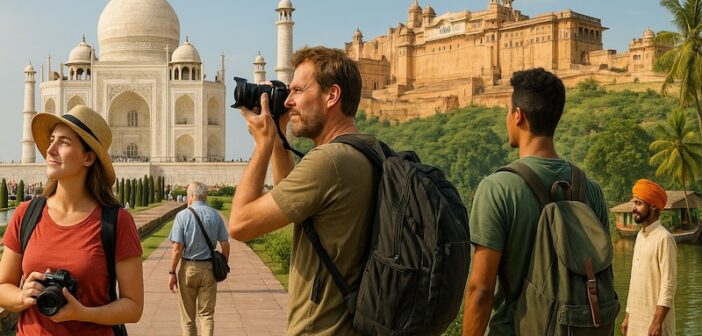TL;DR India’s tourism is bouncing back post-COVID-19 disruptions. With 9.96 million foreign arrivals in 2024 and Rs 2.93 lakh crore in foreign exchange earnings, the country is now the 8th largest travel economy in the world. Tourists come primarily for leisure, business, and diaspora visits, while medical tourism remains a steady draw. Asia leads as the leading source of foreign tourists, Oceania and Africa in long stays, and the 25–44 age group dominates. Post-pandemic shifts reveal resilience, adaptation, and a rapidly evolving tourism landscape.
Context
Tourism in India is no longer just a showcase of heritage and culture; it has become a powerful economic engine. Mega-events like Maha Kumbh 2025, digital collaborations with platforms like Netflix, and domestic campaigns such as ‘Dekho Apna Desh’ are reshaping the sector. Medical tourism also remains a strong driver of foreign tourists to India.
Union Tourism Minister Gajendra Singh Shekhawat emphasises India’s ambition to rank among the top four global tourism economies within a decade, fuelled by infrastructure upgrades, heritage revival, and global partnerships. With foreign exchange earnings hitting ₹ 2.93 lakh crore in 2024, and India climbing to 8th place globally, understanding who visits, why, and for how long is critical to sustaining this growth.
Who Compiles This Data?
The Ministry of Tourism, Government of India, collects and publishes annual data through the India Tourism Data Compendium.
Where can I download Clean & Structured Data about India’s Tourism related Statistics?
Clean, structured, and ready-to-use datasets related to Year and Nationality-wise Foreign Tourist Arrivals in India can be downloaded from Dataful.
Key Insights
Purpose of Visit: Leisure Rules, But Business & Diaspora Matter Too
35–55% of tourists visited for leisure, holidays, and recreation between 2020–2024, drawn by the country’s history, culture, and landscapes.
- Pandemic effect: In 2021, leisure travel plummeted to 8.98%, while Business & Professional visits (30.65%) and Indian Diaspora travel (23.59%) surged. This spike reflects essential travel, business commitments, and diaspora visits following international border closures.
- Diaspora travel: Ranged from 20–63%, particularly high in Oceania and the Middle East. The 2021 surge mirrored the return of Indian nationals abroad once the COVID-19 restrictions eased.
- Medical tourism: Peaked at about 16% in 2021, as postponed elective treatments resumed, then stabilised at 5–10%, showing steady demand for India’s healthcare offerings.
- Post-2022 rebound: Leisure travel quickly recovered, while business, diaspora, and medical visits normalised, signalling a return to pre-pandemic patterns and the resilience of India’s tourism sector.
Average Duration of Stay: Long Trips for Some, Short for Others
With 9.96 million foreign tourist arrivals in 2024, India saw an average of more than 27,000 foreigners arriving each day. However, not all tourists linger equally; the continent of origin heavily influences stay lengths.
- Asia: Leads in volume (12.87 million arrivals between 2020 & 2024) with an average stay of 27 days, reflecting a mix of leisure, business, and diaspora visits.
- Americas & Europe: 7.46 million and 7.31 million arrivals respectively between 2020 & 2024, with shorter stays of 23.1 and 20.9 days, mainly for business or short leisure trips.
- Oceania & Africa: Smaller volumes (1.71 million and 0.81 million between 2020 & 2024) stay the longest, averaging 32.2 and 27.1 days, largely for medical tourism and extended family visits.
Age Profile: Young & Mid-Age Tourists Lead
India attracts adventurous, active travellers:
- Ages 25–44 dominate with 40–42% of arrivals, drawn by adventure, leisure, and work opportunities.
- Younger tourists (15–24) make up 7–15%, while seniors (55+) remain ~10–15%, often focused on cultural and wellness tourism.
This generational spread underscores India’s broad appeal, catering to both youthful explorers and culturally-inclined older travellers.
Why Does It Matter?
Understanding who visits India, why, and how long they stay drives strategic tourism planning:
- Infrastructure: Optimising hotels, transport, and digital amenities for varied stays and purposes.
- Marketing: Tailoring campaigns to nationality, purpose of visit, and age group.
- Policy: Improving visa facilitation, medical tourism support, and safety regulations.
India’s tourism story is no longer only about heritage; it is a multifaceted engine of jobs, revenue, and global visibility, and data-driven insights help make informed policy decisions.
Key Numbers (from 2020 to 2024)
- Total FTAs (in millions):
2020: 2.74 → 2022: 6.44 → 2024: 9.96 - Dominant Purpose: Leisure, Holiday & Recreation (~32–75% by nationality)
- Average Stay: 5–87 days, depending on nationality & purpose
- Age Profile: 25–44 yrs dominate (40–42%)



